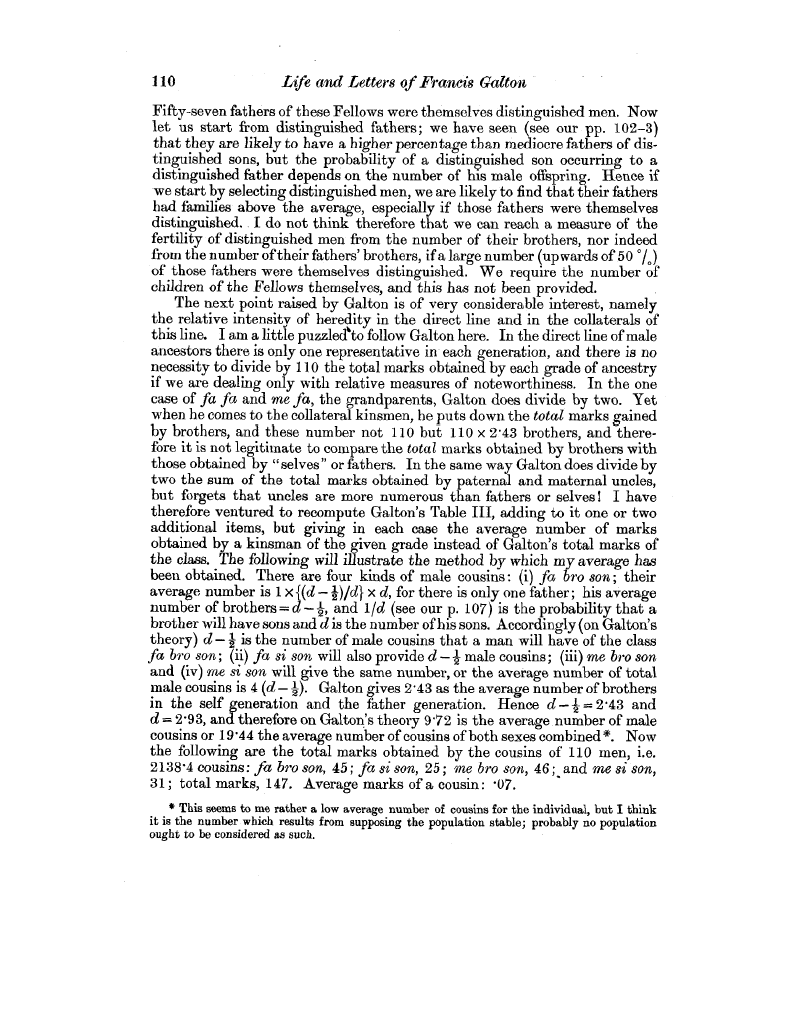110 Life and Letters of Francis Galton
Fifty-seven fathers of these Fellows were themselves distinguished men. Now let us start from distinguished fathers; we have seen (see our pp. 102-3) that they are likely to have a higher percentage than mediocre fathers of distinguished sons, but the probability of a distinguished son occurring to a distinguished father depends on the number of his male offspring. Hence if we start by selecting distinguished men, we are likely to find that their fathers had families above the average, especially if those fathers were themselves distinguished.. I do not think therefore that we can reach a measure of the fertility of distinguished men from the number of their brothers, nor indeed from the number of their fathers' brothers, if a large number (upwards of 50 °/O) of those fathers were themselves distinguished. We require the number of children of the Fellows themselves, and this has not been provided.
The next point raised by Galton is of very considerable interest, namely the relative intensity of heredity in the direct line and in the collaterals of this line. I am a little puzzletto follow Galton here. In the direct line of male ancestors there is only one representative in each generation, and there is no necessity to divide by 110 the total marks obtained by each grade of ancestry if we are dealing only with relative measures of noteworthiness. In the one case of fa fa and me fa, the grandparents, Galton does divide by two. Yet when he comes to the collateral kinsmen, he puts down the total marks gained by brothers, and these number not 110 but 110 x 2.43 brothers, and therefore it is not legitimate to compare the total marks obtained by brothers with those obtained by "selves" or fathers. In the same way Galton does divide by two the sum of the total marks obtained by paternal and maternal uncles, but forgets that uncles are more numerous than fathers or selves ! I have therefore ventured to recompute Galton's Table III, adding to it one or two additional items, but giving in each case the average number of marks obtained by a kinsman of the given grade instead of Galton's total marks of the class. The following will illustrate the method by which my average has been obtained. There are four kinds of male cousins : (i) fa bro son ; their average number is 1 x{(d - 1)/d} x d, for there is only one father; his average number of brothers = d - 2, and 1 Id (see our p. 107) is the probability that a brother will have sons and d is the number of his sons. Accordingly (on Galton's theory) d - yl is the number of male cousins that a man will have of the class fa bro son; (ii) fa si son will also provide d - I male cousins; (iii) me bro son and (iv) me si son will give the same number, or the average number of total male cousins is 4 (d- Q). Galton gives 2.43 as the average number of brothers in the self generation and the father generation. Hence d--g1-2-43 and d = 2 and therefore on Galton's theory 9'72 is the average number of male cousins or 19.44 the average number of cousins of both sexes combined*. Now the following are the total marks obtained by the cousins of 110 men, i.e. 2138'4 cousins : fa bro son, 45; fa si son, 25; me bro son, 46;, and me si son, 31; total marks, 147. Average marks of a cousin: -07.
* This seems to me rather a low average number of cousins for the individual, but I think it is the number which results from supposing the population stable; probably no population ought to be considered as such.
